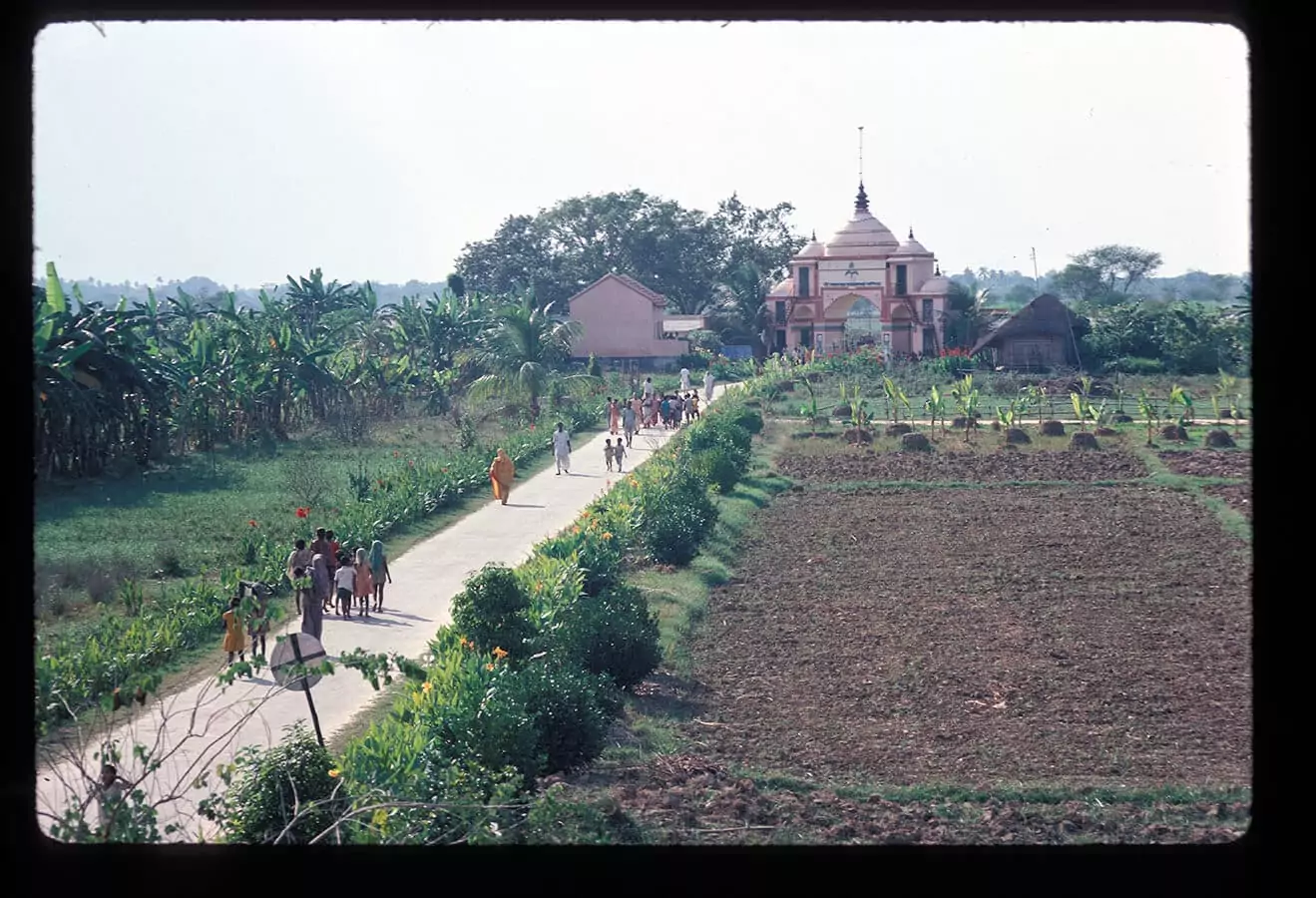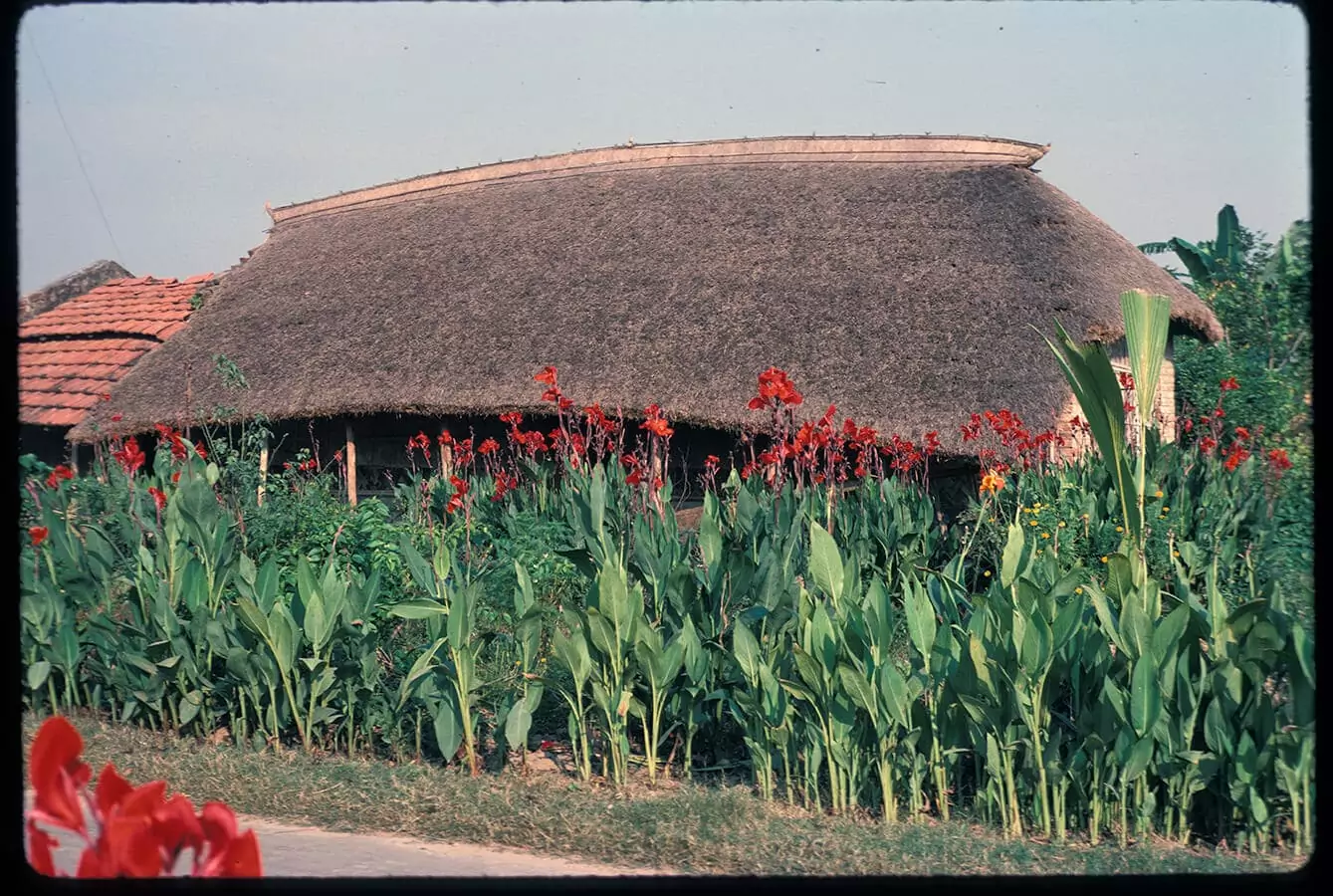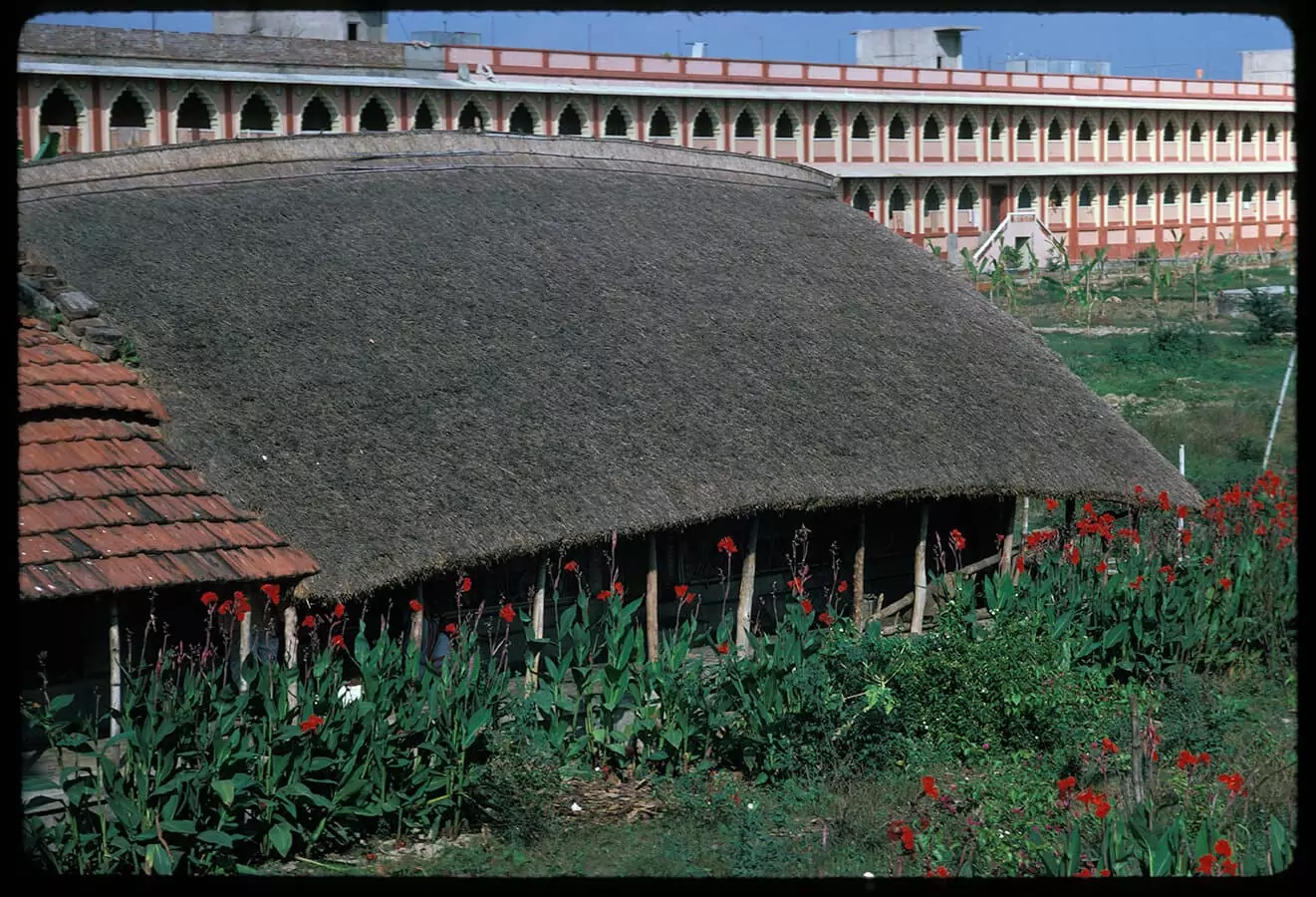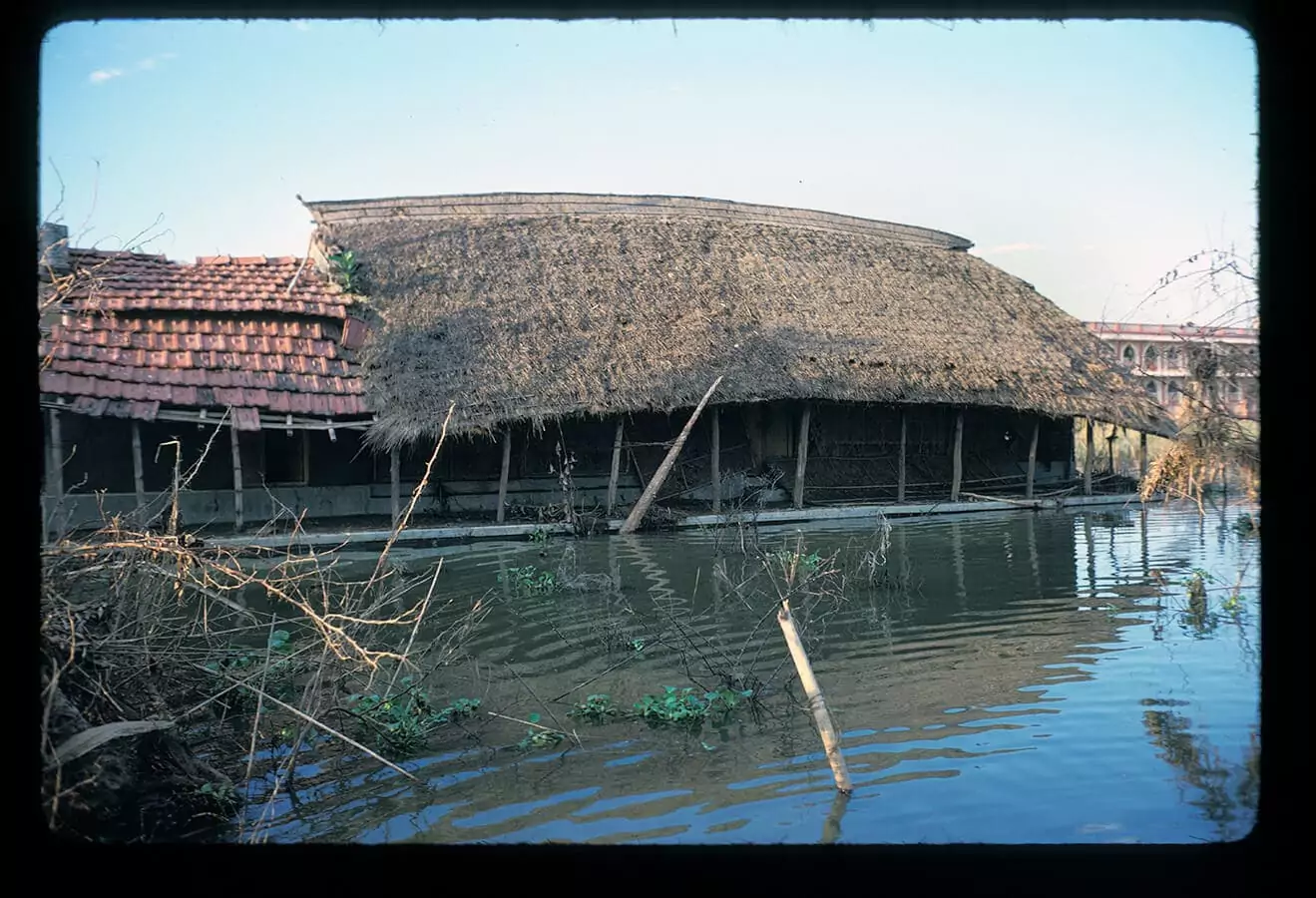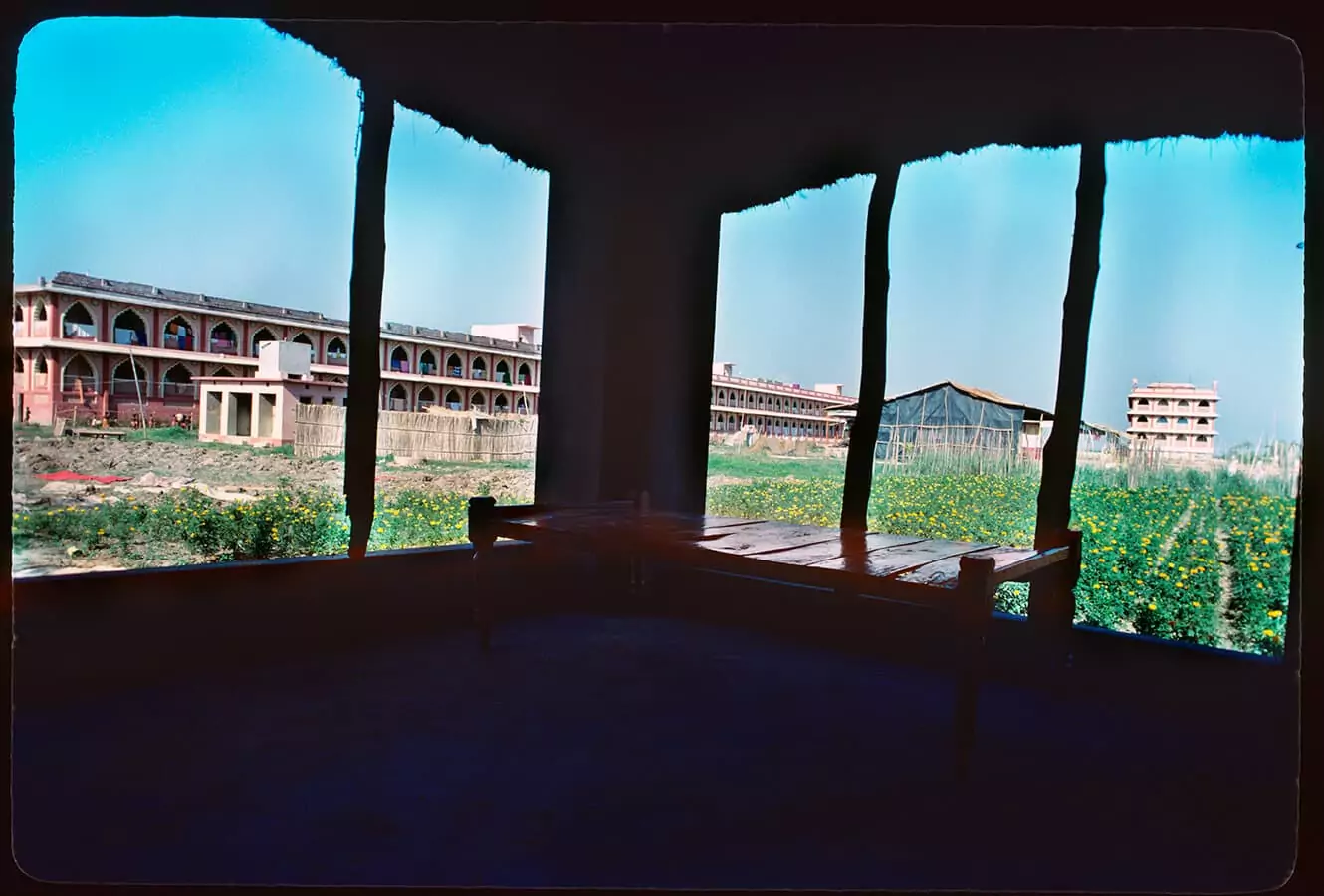 Srivasa Thakura, one of the members of the Pancha-tattva, lived in Navadvipa-dhama in Mayapur, near the residence of Jagannatha Mishra and Sacidevi, where Sri Chaitanya Mahaprabhu appeared. Later, when Lord Chaitanya began His sankirtana movement in Navadvipa-dhama, He and His other most confidential associates would meet at Srivasa-angana, the home of Srivasa Thakura, and have kirtan throughout the night. The kirtans at Srivasa-angana were ecstatic, and only the most intimate devotees of Sri Chaitanya Mahaprabhu were allowed to enter. In fact, the nocturnal kirtans at Srivasa-angana in gaura-lila are compared to the rasa dance in krsna-lila.
Srivasa Thakura, one of the members of the Pancha-tattva, lived in Navadvipa-dhama in Mayapur, near the residence of Jagannatha Mishra and Sacidevi, where Sri Chaitanya Mahaprabhu appeared. Later, when Lord Chaitanya began His sankirtana movement in Navadvipa-dhama, He and His other most confidential associates would meet at Srivasa-angana, the home of Srivasa Thakura, and have kirtan throughout the night. The kirtans at Srivasa-angana were ecstatic, and only the most intimate devotees of Sri Chaitanya Mahaprabhu were allowed to enter. In fact, the nocturnal kirtans at Srivasa-angana in gaura-lila are compared to the rasa dance in krsna-lila.
In his identity in krsna-lila, Srivasa Pandita is Narada Muni, the great preacher who travels throughout the universe chanting the holy names of Krishna and enlightening the fallen souls in Krishna consciousness. So it is most auspicious that His Holiness Sridhar Swami Maharaja left on Srivasa Thakura’s appearance day—that most auspicious day—in Sri Mayapur-dhama—that most auspicious place.
We now have a special opportunity and responsibility to honor and glorify His Holiness Sridhar Swami Maharaja.
My own association with Sridhar Swami goes back to Bombay, over thirty years ago. Srila Prabhupada had requested disciples from America to come to India to help him there, and in particular with his three main projects—Bombay, Mayapur, and Vrindavan. From 1972, Sridhar Swami served Srila Prabhupada in India, mainly in Bombay.
When we got permission from the municipality to build on Hare Krishna Land in Juhu, Srila Prabhupada wanted Sridhar Maharaja to take charge of the construction materials. Sridhar Maharaja had a hefty build, like a football player, so Srila Prabhupada thought he would be appropriate to keep track of the construction material and make sure none of it was stolen. But Sridhar Maharaja (he wasn’t a sannyasi then, so Sridhar das Brahmachari) said that he didn’t want to look after the construction material; he wanted to preach. I was the temple president in Bombay, so I was going back and forth between him and Srila Prabhupada. Srila Prabhupada again said that Sridhar Maharaja should look after the construction materials, so I went back to deliver the message to him, but Sridhar Maharaja insisted, “I want to preach!”
Maharaja had never really preached much in India before then, and we didn’t know how well he could preach to the aristocratic Indian gentlemen we were mainly approaching at that time. But he was so sincere in his desire that he became one of the best preachers in India, one of the best in the world. This story illustrates Maharaja’s sincere desire to preach, and his strong determination to serve Srila Prabhupada and the mission even in ways that he may not have found easy.
In India, Srila Prabhupada had introduced the life-membership program. And he based the society’s progress there on its level of success. He said that making someone a life member was almost as good as making him a devotee. He had introduced the program as a way to distribute his books, he explained, because if someone became a life member by paying a certain subscription, he would get a set of the books and a subscription to Back to Godhead magazine.
Eventually, Sridhar Swami led one of the life-membership teams in Bombay. I was the membership director, and the other team leaders were Maharaja, Lokanath Swami, Jagat-purusa Prabhu, and Haridasa Prabhu. In the early 1980s, Sridhar Maharaja became the Juhu temple president, and so he increasingly joined me in cultivating the most important people in Bombay. And between 1984 and 1990, when I was unable to return to India because of visa problems, Maharaja deepened his relationship with many of our most important members and they came to love him deeply.
In around 1991, Sridhar Maharaja proposed a fund-raising-by-mail program in Juhu. Many devotees criticized the idea, saying it would never work. To prepare the letters and post them would cost more than two lakhs—two hundred thousand—rupees, and there was no guarantee that we would ever get the money back. But in spite of all the negativity, Maharaja took the risk—Srila Prabhupada had said, “To preach means to take risks”—and the experiment proved to be successful. The first effort itself made money, and subsequent mailings proved even more profitable. Soon, Maharaja received invitations from centers in India and abroad to help them organize fund-raising-by-mail campaigns, and the campaigns proved to be successful everywhere. They became one of the most reliable sources of income many temples had. Even today, the BHISMA (Bhaktivedanta Information Services and Mailing) office started by Sridhar Maharaja raises funds for the Juhu temple by mail.
More recently, Sridhar Maharaja started the pioneering Vedic Applied Spiritual Technology (VAST) program, which used the latest multi-media methods to teach the corporate sector stress management and time management—all in relation to Krishna consciousness. Maharaja always tried to find innovative ways to present Krishna consciousness. He studied experts in various fields and applied what he learned to Krishna consciousness.
Many of my most vivid memories of Maharaja, and of his good influence on me and on others, are from the last few years. You may know that in 1977, some months before he left this world, Srila Prabhupada named eleven disciples to initiate devotees on his behalf while he was still here. After he left, the same disciples continued to initiate, and later, slowly, a few more, beginning with three others, were given that responsibility. Sridhar Maharaja was not one of the first to initiate, or even one of the early ones to be added; the attitude in the movement then was quite restrictive. At one stage, he joked that he wanted only three disciples—one to cook, one to do his laundry, and one to collect for him.
Eventually, Maharaja was given the responsibility to initiate disciples, and he took his duty very seriously; he was very sincere. In his first initiation ceremony, in Juhu, he gave hari-nama to a devotee from Croatia, whom Maharaja named Mayapur dasa and instructed to be a servant of Sri-dhama Mayapur. Even up to the end, Maharaja was very sincere in his duties to his disciples and in his care and affection for them. He really loved them very much. At the same time, he cared for devotees and people in general, and I think this is one of his most remarkable traits: his almost universal care for others. He was like an ocean of love.
In Kartik of 1999, Sridhar Maharaja and I met in Vrindavan. One morning we went to the Bhaktivedanta Ashram at Govardhana, where I was to meet His Holiness Indradyumna Swami and choose a Govardhana sila to worship. Indradyumna Maharaja placed two silas next to each other on his shelf and asked, “Who do these look like?” They looked like Radha and Krishna, and so I accepted them, and Indradyumna Swami also gave me his deity of Gopesvara Mahadeva. Earlier, he had told Sridhar Maharaja, “I will have something for you when you come to Govardhana.” Sridhar Swami was a great devotee of Lord Nrsimhadeva, and Maharaja gave him silas of Lord Nrsimhadeva and Varahadeva.
The next day, Indradyumna Swami took Sridhar Maharaja and me to Loi Bazar in downtown Vrindavan to get paraphernalia for our worship. We spent most of the day in various shops, looking for just the right items for the deities’ service and bargaining with the merchants. Finally, we became satisfied that we had done the best we could for our worshipable Lords—and besides, we all were hungry—and so we returned to the Krishna-Balarama Mandir.
During the same stay in Vrindavan, Sridhar Maharaja and I did Govardhana parikrama together with a group of devotees. We had wonderful krsna-katha all around Govardhana Hill. Although we both were ill, we did the full parikrama barefoot in the hot sun, and only afterward did we take prasada at the Bhaktivedanta Ashram.
Within a month, Maharaja and I were both in the hospital—he in a coma, with encephalopathy from hepatitis C, and me on the verge of a heart attack, about to have cardiac bypass surgery. Later, he praised the power of that parikrama—that it put us both in the hospital so quickly. He told me, “The only reason I went all the way around was to keep up with you.” And I replied, “But, Maharaja, the only reason I went all the way around was to keep up with you!” Such was our relationship, and such is the mercy of Giri-Govardhana.
Maharaja had been diagnosed with hepatitis C two years earlier—and with cirrhosis of the liver, a condition that over time is usually fatal. After Kartik, his condition deteriorated, and some fluid, called ascites, accumulated in his abdominal cavity—nearly twenty or twenty-five liters, which also caused massive swelling in his legs. So he returned to Bombay for tests and treatment.
In Bombay, Maharaja was admitted to Bhaktivedanta Hospital, which is run and staffed mainly by devotees. There, he had a further reversal and fell into a coma. His Holiness Tamal Krishna Goswami and some of Goswami Maharaja’s close friends—Giridhari Swami and Kesava Bharati Maharaja—came from Vrindavan to Bombay to visit Sridhar Swami in the hospital. Maharaja was very grateful to them for coming all the way from Vrindavan to be with him, and their visit had a deep effect. From then on, one of the main themes in his life was how much he appreciated his godbrothers, how much he wanted their association. He would say, “My godbrothers are my life,” and, as a humble Vaishnava, he felt dependent on them. Even at the end, in Canada, just before he left for Mayapur for the last time, he was asking different godbrothers, “Please help me. Help me to chant the holy name.” He was very, very humble.
Eventually Maharaja was discharged from the hospital, but his condition remained delicate. Many devotees suggested that he return to Vrindavan and spend his last days there, hearing and chanting about Krishna. Again, he was so sincere that he accepted the advice of his godbrothers and well-wishers. But soon he felt, “This is not me, just to sit and chant and hear in Vrindavan.” And again he came to the same point: “I want to preach.” So, Maharaja stayed in Haridas Prabhu’s vacant flat at Mira Road in Bombay, and there he would meet devotees and friends—and preach.
In April of 2000, in an early stage of a hepatic coma, Maharaja was readmitted to Bhaktivedanta Hospital, and soon thereafter he had difficulty breathing and felt that he might actually leave his body. But he recovered from the crisis, and soon he got the idea that he would like to travel again. And he was adamant.
From the medical point of view, to travel was a doubtful decision, but Maharaja was determined. His first stop was to be Carpinteria, where I have a small ashram. He wanted to visit, spend some time with me, and rest and recuperate. Thus, in May of 2000, he and Mayapur dasa somehow got on a plane and reached Los Angeles. From the Los Angeles airport they came straight by car to Carpinteria, but by the time Maharaja reached the ashram, he was in a terrible condition. We were shocked. Already he had been terribly sick, but then he had caught the flu in Bombay, though the symptoms hadn’t manifested until he had reached Hong Kong. Some devotees said that he shouldn’t have traveled at all—he was too sick—and that the disease was affecting his discrimination. But in retrospect, I see his traveling in spite of his illness as his love and his desire to serve and preach. And sometimes I take it that he risked his life just to come and visit me.
So, he came, and we spent some time together. He was on a very strict diet that he didn’t much like, and he would cheat a little now and then. One night I went out to a preaching program. Maharaja wasn’t well enough to come, but he encouraged me to go, so we left him in the care of Mayapur dasa and my disciple Kuntidevi dasi, who could cook in case he needed anything. After I left, he decided that he wanted to indulge himself a little and asked for veggie burgers and French fries, which were not at all on his diet. Kuntidevi dutifully prepared them, and Mayapur reluctantly served them. Maharaja ate them, and he was in very jolly spirits.
In Bombay we had two highly aristocratic yet very devoted life members—Mr. Brijratan Mohatta and Mr. M. P. Maheshwari. Every Sunday, they and their wives would come to Juhu. Out of their deep affection for Maharaja, these two gentlemen began to call him “the jolly swami” because, well, he was always so jolly. The name stuck, and a few years ago, Maharaja’s brother Stuart actually wrote an article about him called “The Jolly Swami,” which was published in a magazine in Canada. Recently, the nickname became even more popular—and deservedly so—because Maharaja remained so jolly even up to the time of death.
So, happily enjoying Kuntidevi’s tasty burgers and chips, “the jolly swami” was in a very jolly mood indeed. The next morning, however, he wasn’t quite so jolly—or at least he didn’t manifest his mood. In fact, he wouldn’t get up. We thought, “He must be exhausted.” Time passed, and still he wouldn’t get up. We waited, tried again, waited, and tried again. Finally, we realized that he was in a coma, so we rushed him to the hospital, to the emergency room, and he was eventually put in the intensive care unit.
Physiologically, there was a certain course to be run, and the doctors were confident that Maharaja would come out of the coma. It just had to be treated in the proper way and the condition would reverse itself. Again, Maharaja’s great affection and care became evident. Because of the liver’s malfunction, it wasn’t able to take out the toxins—that was the basic problem. And eventually the toxins go to the brain and cause encephalopathy. If the toxins in the brain reach a certain point, the patient goes into a coma. Then the process of coming out of the coma and toxic influence is gradual. In a way, you could say that at first Maharaja was sort of delirious. But the beauty of his delirium was that his goodness came out freely: He just wanted everyone to chant. He wanted everyone—the doctors, the nurses, the nurses’ assistants, the room cleaners—to become Krishna conscious. He really just wanted everyone to become Krishna conscious.
And then, too, he would think of his brothers, Malcolm and Stuart, in Canada. He really wanted them to become devotees. He would talk to us about them, not completely coherently, but with great love and care. And he would talk with them on the phone, as well as with his mother and sister. He saw some spark in them that he wanted to fan. He really wanted them to become devotees.
When the crisis began, we informed his family. His sister, Fiona, was just wonderful—so helpful and responsible. And eventually his brother Malcolm came down and stayed with Maharaja and us for a while. Hridayananda Maharaja also visited Maharaja in the hospital. And again, Sridhar Maharaja was so appreciative. The two of them joked a lot, and soon Sridhar Maharaja was discharged and came back to the ashram. Throughout, despite his trying medical condition, he really was “the jolly swami,” so friendly to the nurses and staff and everyone.
After some days, the bill from the hospital came—for almost $30,000. Maharaja studied it carefully. Finally, he concluded: “I want my money. They can take back my consciousness!” And later, after he had left, he would phone and say, “I want to come to Carpinteria and have some more of Kunti’s ‘coma burgers’!”
From then on, despite his hepatitis, Maharaja would travel a lot, sort of like Srila Prabhupada—more or less six months in India, based in Bombay, and six months traveling. He would visit London and Croatia and Slovenia, and he would always attend the New York Ratha-yatra. He made a point always to go to the New York Ratha-yatra. And he would regularly visit Alachua, Los Angeles, Vancouver, and Brazil. He had many disciples in Croatia and Slovenia; many young people there became initiated by him.
In September of 2001, accompanied by Nrsimhananda Prabhu of ITV, Maharaja came to Carpinteria for my Vyasa-puja. “For me, in my stage of life,” he said in his offering, “if I have learned even one little lesson, it is dasa-dasanudasah. Cultivate service to the Vaishnavas and you will get everything. We need a family in which we can love and trust each other and not fear. We have to preach to so many materialistic people. Their very aura is permeated with lust and greed and anger, and there is a possibility of getting infected. But if we can come back to a community of friends, of brothers and sisters, where we love each other and care—I am not talking of superficially saying something, but where we really care deep down inside that this person is suffering and care, even materially—we will be protected. Prabhupada cried when he saw people suffering materially in the material world. So, what to speak of exalted Vaishnava devotees—we should care for them and love them. This is our family.”
January 14, 2003, marked the twenty-fifth anniversary of the grand opening of the Juhu temple, and Sridhar Maharaja took the lead in arranging the silver-jubilee celebrations. He wanted every devotee who had ever served in Juhu to come, especially those who had served in the time leading up to the grand opening, which was basically when Srila Prabhupada was personally present. The Juhu temple had a modest budget to help devotees with their airfares, but eventually another very nice devotee in Bombay, Krishna Chandra Prabhu (Hrishikesh Mafatlal), gave several lakhs of rupees to pay for devotees’ tickets. Maharaja tracked down every Prabhupada disciple who had served in Bombay. He phoned and personally requested them to come and offered free tickets as required.
So many came and the event was extraordinary. People couldn’t believe it—everyone there felt that Srila Prabhupada had manifested himself again. Even His Holiness Sacinandana Swami, who hadn’t served in Bombay earlier but who happened to be there for the celebrations, said that he tangibly felt Srila Prabhupada’s presence. Everyone gave credit to Sridhar Swami. And he deserved it, because he had gotten so many devotees to come and, with help from devotees in Chowpatty and Juhu, had made such wonderful arrangements.
During the ceremony, when it was time for the devotees to give their remembrances of the early days of serving Srila Prabhupada in Bombay, Maharaja wouldn’t allow the gurus and sannyasis to speak until other devotees had spoken. “We hear them all the time,” he said. “We want to hear others.” Of course, they also spoke, but mainly Maharaja wanted to give others the chance. He really was pandita sama-darsinah: he saw everyone equally. He truly saw the soul, and he appreciated everyone. He appreciated everyone’s good, and he wanted to encourage everyone.
Anyway, it was a wonderful event. Due to my own health problems, I couldn’t be there, but I phoned, just to be part of the celebrations. The guesthouse receptionist picked up the phone, and I asked for Maharaja, but he wasn’t nearby and it was going to take time to find him. In the meantime, I asked, “Who else is there?” Jagat-purusa Prabhu happened to be walking by, so I said, “Okay, I’ll speak to him.” Jagat-purusa was in high ecstasy. He wasn’t speaking; the ecstasy within him was moving him to speak. He said that he had not experienced such bliss in Krishna consciousness since the time he had been in Bombay with Srila Prabhupada. He went on and on, emphasizing that it was the most memorable occasion of his life, and I think everyone felt pretty much the same way, because they felt Srila Prabhupada’s presence. What more do any of us want? For us, the highest perfection is to be with Srila Prabhupada, and Sridhar Swami was instrumental in creating that situation in which Srila Prabhupada was pleased to manifest himself in such a vivid and personal way.
After a few days of recuperating from the effort of the celebration, Maharaja wanted to travel again, so he came to Los Angeles, but this time his schedule didn’t allow him to come to Carpinteria. Also, I think he was a little upset because I hadn’t come for the celebrations in Juhu, and he didn’t want to come to me. So I went to him, and, as always, he was wonderful. After Los Angeles, he went to Vancouver, and while he was there, I began to consider that I had offended him by not going to Juhu for the celebrations. I don’t think I could have gone, but at the same time I was concerned that I had offended him. So I phoned him to apologize and explain why I hadn’t gone, even though he and many others had so much wanted me to participate. I asked him to forgive me, and he was very gracious. He was sorry I hadn’t come, and he did want to understand why, but he said I hadn’t committed any offense.
Subsequently, Maharaja and I would frequently talk on the phone, and we would meet whenever he came to Los Angeles. Then, last November, he phoned from Bombay and told me he was planning to go to Vancouver in April for four to six months. I replied, “I will definitely come and spend time with you there.” Soon thereafter, however, I got an e-mail from him saying that he had been diagnosed in Bombay with liver cancer and was going to Vancouver immediately to see if he could get a liver transplant, which was his “only hope.”
So, Maharaja flew to Vancouver, and the first day he went for tests, the doctors found three places where cancer had affected his liver, which prima facie made him eligible for the transplant. When they did more tests, however, they found more cancer—and because the cancer had spread beyond the limit allowed for transplants, his “only hope” was dashed: he was ineligible for a transplant. So, it seemed like he was soon to leave his body.
Distressed, I phoned Maharaja, but he wasn’t answering his landline. When I finally got him on his cell phone, I asked, “Where are you?” and he said, “I’m shopping.” He seemed so jolly—like always. But then he confirmed my worst fears: “The doctor says that I could go at any time. Phone me back later. We have to talk.”
After that, we would speak every day, usually twice a day—long, wonderful talks. The question arose whether he should go to Mayapur. He decided he would, and eventually, in consultation with his godbrothers, he concluded that he should go as soon as possible.
He told me he had three desires: “I just want to survive until I reach Mayapur. Then, if possible, I want to live to see the Pancha-tattva installed. And then, if possible, I want to live until Gaura-purnima. And then—whatever.” He meant, of course—whatever Krishna wanted.
With these three desires in his heart, although no one knew how much travel his weakened body could bear, Maharaja flew to London, where he was joined by Indradyumna Swami. His sister, Fiona, had informed Indradyumna Swami of the doctor’s pronouncement, that if Sridhar undertook the journey, he probably wouldn’t make it. And she added, “If that happens, I want someone to be there with him.” So Indradyumna Swami flew to England to accompany Maharaja onward to Mayapur.
In London, devotees had rented a room for Maharaja in a hotel near the airport. He was so sick and weak that he could hardly walk. The devotees just had to get him from the airport to the nearest place possible—as soon as possible.
Because the news had spread that Maharaja was going to Mayapur to leave his body, many of his disciples from Europe—mainly from Croatia and Slovenia—came to London to meet him. They were crying because they knew they would never see him again. He told them, “You can cry when I go. You can cry for a few days, but then you have to get back into your service, and then you have to be happy.”
Maharaja wanted to reciprocate with the disciples who had come to be with him. He said, “The king is good for the people, and the people are good for the king. I never had my own family, but when I had disciples, I was able to benefit tremendously. I felt emotions I thought I never would. I just don’t think it will stop. When we love one another, we are together. Of course, when I leave, we can’t play football [soccer] together. But I can come along in the form of a picture.” It was so bittersweet; Maharaja was so sweet and so humorous. Yet his disciples were lamenting that they would never see him again. But he told them, “When I leave, we can be together in more significant ways.” He said that love in separation is actually stronger. And we do experience that when we are with people we love, we may take them for granted. But when they are gone, we realize how valuable their association was and how much we loved and still love them. And the feelings can become even more intense than when we were with them.
There were some disciples who didn’t have second initiation, so Maharaja decided to initiate them. Because of his disease, however, his brain didn’t always function properly. It had been infected by the toxins, and also he had to take an opioid painkiller, as prescribed by the doctor. So, he decided, “Okay, I’ll give second initiation—but all together, all five at once.” Still, when he began reciting the Gayatri mantra—“Om bhur . . .”—he couldn’t remember the next word. So he asked Indradyumna Swami, “What comes next?” and Indradyumna Swami pronounced the word and Maharaja repeated it to his disciples. When Maharaja couldn’t remember the next word either, he told Indradyumna Swami, “Look, why don’t you just say each word, and then I’ll repeat it, and the disciples will hear it from me.” And like that, they got through the first two lines. Then Indradyumna Swami, who himself was exhausted from his long flight from South Africa, couldn’t remember the next word. So Maharaja asked, “Are there any brahmans in the house who know the next word?” and one brahman told the word to Indradyumna Swami, and Indradyumna Swami repeated it to Sridhar Swami, and Sridhar Swami repeated it to the disciples.
Sridhar Maharaja remarked, “Harer nama harer nama harer namaiva kevalam. We don’t need this Gayatri mantra. Hari-nama is enough.” Then he started quoting:
harer nama harer nama
harer namaiva kevalam
kalau nasty eva nasty eva
nasty eva gatir anyatha
[“In this age of quarrel and hypocrisy the only means of deliverance is the chanting of the holy names of the Lord. There is no other way. There is no other way. There is no other way.” (Brhan-naradiya Purana 3.8.126, quoted as Cc Adi 17.21)]
krsna-varnam tvisakrsnam
sangopangastra-parsadam
yajnaih sankirtana-prayair
yajanti hi su-medhasah
[“In the Age of Kali, intelligent persons perform congregational chanting to worship the incarnation of Godhead who constantly sings the name of Krsna. Although His complexion is not blackish, He is Krsna Himself. He is accompanied by His associates, servants, weapons, and confidential companions.” (SB 11.5.32)]
kaler dosa-nidhe rajan
asti hy eko mahan gunah
kirtanad eva krsnasya
mukta-sangah param vrajet
[“My dear King, although Kali-yuga is an ocean of faults, there is still one good quality about this age: Simply by chanting the Hare Krsna maha-mantra, one can become free from material bondage and be promoted to the transcendental kingdom.” (SB 12.3.51)]
When Maharaja had quoted all these verses in glorification of the holy name, Indradyumna Swami exclaimed, “Maharaja, you are perfectly quoting all these verses about the holy name, but you can’t remember the Gayatri mantra?!” Sridhar Swami explained, “The Gayatri mantra is just meant to assist us in chanting the holy name. The real thing is chanting the holy name. The Gayatri mantra just supports it—helps us to become purified—so we can chant the holy name.”
You may have heard how Maharaja arrived in Calcutta. Jayapataka Swami had sent his van to pick him up, and Maharaja lay unmoving in Jayapataka Swami’s bed in the van all the way from the airport to Mayapur. In Mayapur, thousands of devotees came out to receive him with kirtan—sometimes roaring and sometimes sweet.
Because Maharaja’s diseased liver wasn’t processing different materials properly, his body again filled with liquid and became bloated. In Canada, as well as in India, doctors would remove five to seven liters of liquid from him at a time. That was part of his discomfort. And after the installation of the Pancha-tattva, he had a physical setback, maybe because of the exertion and excitement in the ceremony. The situation looked grave, and in the evening he asked for devotees to come and do kirtan in his room. He didn’t know what would happen, but it looked like he was going to leave his body. Mayapur dasa informed the devotees, so they came: senior devotees and disciples alike gathered in Maharaja’s room, ready for the worst. As he lay silently on his bed, they performed kirtan, most of them crying, seeing that the end was near. A doctor was called to Maharaja’s bedside and felt around Maharaja’s torso as Maharaja lay motionless, his eyes closed. Maharaja’s abdomen was bloated from the accumulated fluids. The doctor put his hands on Maharaja’s abdomen and gently squeezed it to assess the situation—at which Maharaja opened his eyes, looked in the doctor’s direction, and said, “It’s a boy!”
Everybody cracked up. Maharaja was so funny, even in the most dire of circumstances. The devotees were going mad; they didn’t know whether to laugh or cry. The situation was so critical, yet Maharaja was so funny. Maharaja told me that story on the phone, and I could tell he rather liked it.
So, jiva va mara va: a devotee can live or die. Both are the same. Certainly that was true of Sridhar Swami: he could live or die, because if he lived he would serve Krishna here, and if he died he would serve Krishna in the next life. For Maharaja, life and death were the same (jiva va mara va). Thus, he was truly fearless and jolly. He really had no fear of death. Although he wanted to stay so he could preach, he wasn’t afraid of death. He knew he would continue to serve Srila Prabhupada in the next life.
A few days before Gaura-purnima, Indradyumna Swami came to see Maharaja to say farewell. At Maharaja’s room he met Mayapur dasa, who told him, “Maharaja is in the shower.” From inside, Sridhar Swami overheard the talk and shouted out, “Indie! Is that you, Indie?” He used to call Indradyumna Swami “Indie,” short for Indiana Jones, because Indradyumna Maharaja is such an adventurous preacher. When someone really loves you and is proud of you, he shows you off to his friends, and in this way, Sridhar Maharaja would show off Indradyumna Swami to people who came to his room, saying, “This is our Indiana Jones, but he is the real thing! This one is the real thing!”
“Indie! Is that you out there?” he called out. “Yes, Maharaja.” “Come on in!” “But Maharaja, you are in the shower.” “So what? Come on in.” So, Indradyumna Swami went in, and there was Maharaja without any cover. “Don’t worry about it,” he said. “We are not these bodies!”
Indradyumna Swami was choked up, because he was feeling that he would never see Maharaja again. So he said, “Maharaja, I have come to say good-bye.” Maharaja said, “Don’t say good-bye.” Indradyumna Swami replied, “I may never see you again in this life.” “Don’t you know that old song?” Maharaja asked. And he sang: “Happy trails to you, until we meet again.” And that was it.
So, I think that is a good conclusion, especially for Indradyumna Swami: “Happy trails,” because his trails take him all over the world. Yet all of us, in our own ways, have our own trails and paths in devotional service, and Sridhar Swami wishes that they be happy—until we meet again.
I wanted to phone Maharaja every day, but the way it worked out with the time difference and all the difficulties in getting through to Mayapur, it averaged about every third day that I would speak with him. The last time, two days before he left, he was having a good day. The previous day had been a bad one, but the night before, they had given him some additional medication, so he was having a good day, and we had one of the best talks I have ever had with anyone in my entire life. We spoke mainly about the Mayapur project and Srila Prabhupada’s mission. I’ll cherish that talk—the experience of it and the lessons it contained—for the rest of my life.
That was Thursday, March 11. The next day, Friday, we installed beautiful brass Deities of Gaura-Nitai in our Carpinteria ashram. They had come from Vrindavan, originally commissioned by Mother Kirtida for Tamal Krishna Goswami. I felt that Their coming was also part of Sridhar Swami’s mercy, because he so fervently desired that the glories of the Pancha-tattva be spread and that we build the great temple for Them in Mayapur. So, two representatives of the Pancha-tattva had come, and I felt that Their arrival was his desire.
On Thursday I had told Maharaja, “I don’t know if I will be able to phone you again before then, but the Deities have come and we will install Them Friday evening, and by your mercy we’ll try to serve Them and Their dhama.” And now, whenever I look at Their beautiful forms and appealing faces, I feel that we have to do something for Them—we have to build Their wonderful temple, as Sridhar Swami always reminded me.
This may be Maharaja’s main contribution in recent years, at least to me in my service: He impressed upon me—and upon our entire movement—the importance of the Mayapur project, of the “wonderful temple” (adbhuta mandira) that Nityananda Prabhu had desired for the service of Chaitanya Mahaprabhu and that Bhaktivinoda Thakura had envisioned. Maharaja’s whole life was dedicated to Srila Prabhupada, and he felt that this was one of Srila Prabhupada’s main desires left to be fulfilled. He felt that we had to do it—and that we had to do it; it would benefit the whole society, and the whole world. He would quote Ambarisa Prabhu: “This will be the tide that will make all the boats rise.” So, although Sridhar Maharaja left so many wonderful legacies for us in terms of his personal qualities and activities, one legacy that may serve to unite the movement and fulfill one of Srila Prabhupada’s main desires is his inspiration to push on the construction of the great temple in Mayapur.
When I was a new devotee, in my first couple of years in the movement, I approached Srila Prabhupada one day while he was getting his massage on the veranda of the Calcutta temple. “Srila Prabhupada,” I said, “I have been thinking about what pleases you most.” Srila Prabhupada was so pure, he took every word into his heart. “Yes,” he replied. I said, “The two things that seem to please you the most are distributing your books and building the big temple in Mayapur.” Srila Prabhupada smiled with great appreciation and said, “Thank you very much.”
So, those were Srila Prabhupada’s two main strategies for spreading Krishna consciousness, and Sridhar Swami helped him with both. In his early days, Sridhar Swami was instrumental in developing book distribution in North America. And in his later years, he was involved with the Mayapur project, planning and raising funds for the great temple. And by Maharaja’s mercy, on Gaura-purnima, standing in front of the Pancha-tattva Deities in Laguna Beach, I got the inspiration: “Now it’s time for Mayapur. Sridhar Swami understood that long ago. Now it’s time for me to join the effort, too.” And that was important for me in other ways as well—to let go of the past, to forgive and forget. It was time for everyone to work together for Mayapur, for Sridhar Swami, for Srila Prabhupada, to build the wonderful temple.
When I asked Sridhar Swami how I could help, he requested me to speak about my experiences of Srila Prabhupada related to Mayapur. In 1973, when Srila Prabhupada came to Calcutta from England, he was so enthusiastic and excited about Mayapur. Tamal Krishna Goswami had gotten the first land, we had observed the first Gaura-purnima festival there, and now Srila Prabhupada had come with the plans for the first building. There was a detailed discussion, but at the end Srila Prabhupada said, “If you build this temple, then Srila Bhaktivinoda Thakura will personally come and take you all back to Godhead.” Now I think that this may be my only hope, so I’d better get to work. We’d better build the Mayapur project, because I don’t know how else I will ever get back to Godhead.
His Holiness Sridhar Swami has given me a lifetime of work in service to Srila Prabhupada. Although jiva va mara va, to live or die is the same for a devotee—and certainly that was true of Maharaja—my own feelings are mixed. I think, “He left so much service for me, gave me so many instructions.” I think the same about Tamal Krishna Goswami. “So I must stay and execute his mission.” Even though part of me misses them terribly and wants to be with them, mainly I think, “They left me so many instructions. I have so much service to do for them here.”
Of course, how long we have to do what they have asked, what they would want, all depends on Krishna. Therefore, whatever time we do have left we should use in the best possible way—in Krishna consciousness.
His Holiness Sridhar Swami Maharaja ki jaya! Srila Prabhupada ki jaya! Sri Pancha-tattva ki jaya! Nitai-gaura-premanande hari-haribol!
* * *
EPILOGUE
Three days after Sridhar Maharaja left, while on my daily walk, in Santa Barbara, I suddenly began to experience great bliss, and I felt Maharaja’s presence. Then I felt that he was giving me two instructions. The first was, “I am still here. Be happy.” And the second was, “Just be yourself. Each one of us has his own contribution to make, so just be yourself and make your contribution.”
After he left, I considered what had happened. Clearly, his two instructions were not meant only for me; they were meant for everyone. And they covered all points. He had said it all: “Just be yourself and make your contribution.”
Thank you, Maharaja. We love you.
Hare Krishna.
[From talks by Giriraj Swami in Laguna Beach and Los Angeles, March 14 and 15, 2004]




 By Vijaya Das
By Vijaya Das









